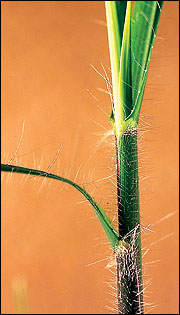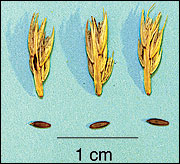Sideoats grama
- Bouteloua curtipendula
Grass
Fine leaves and clumpy growth make sideoats well suited for nesting.
Jim Rathert, Missouri Department of Conservation
Description
Sideoats grama is another warm-season grass that grows as a clump. Characteristics of the species include fine leaves and widely spaced fine hairs along the leaf edge, especially near the collar. Most sideoats plants are 18-24 inches tall at maturity. After formation of the seed head, sideoats will not be mistaken for anything else. It has a unique, oatlike seed that droops slightly off one side of the stalk. Sideoats is relatively easy to plant and establishes quickly, often flowering and seeding the first year. Sideoats grama does best on dry sites such as glades, where it has less competition than on more productive soils. When planted with taller, more aggressive native grasses, it tends to fade away over time.
Use by bobwhites
The fine leaves and clumpy growth form of this species make it excellent for nesting. Sideoats also provides good brood cover in mixed stands with forbs and legumes. Being one of the shorter native grasses in the Midwest, sideoats is desirable for roosting as well. Although seeds have been found in quail crops, sideoats probably is not an important food item.






